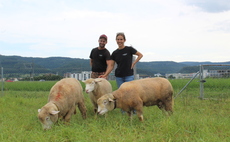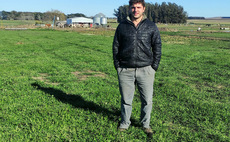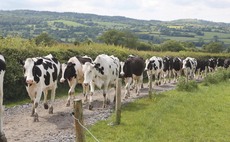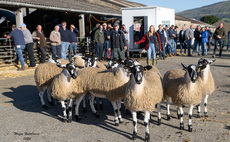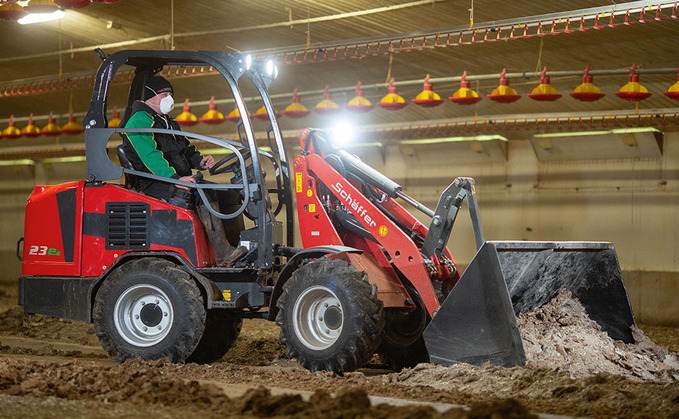
Schaffer was the first loader manufacturer to add lithium-ion batteries, as found in mobile phones and power tools, into a compact loader, the 23e. Alex Heath tests whether the new loader's credentials stack up as a feasible alternative to diesel on a range of common tasks.
As agriculture looks for alternative power solutions, electrically powered machines are inevitably going to become more commonplace in the future. And this year, the LAMMA Show provided the UK launchpad for Schaffer's fully electric 23e loader.
Built on the chassis of the German manufacturer's 2345 model, the drivetrain is much the same, with the contents under the bonnet the exception.
The 23e is the size of machine which will either be used for a few hours at each end of the day, scraping out, pushing up feed and the likes on dairy farms, or used flat out all day for a few days each month, cleaning sheds on pig and poultry units, for example. It is also likely to feature on units with lots of enclosed spaces, where noise and emissions could pose a problem, such as in greenhouses, crop stores or livestock buildings.
The company says the loader is 90 per cent energy efficient, compared to a diesel loader, which it says is just 30 per cent efficient, losing efficiency in the combustion process through heat and noise loss, as well as mechanically throughout the drivetrain.
Savings
It reckons although it commands a premium in the purchase price, by £7,200 (with one battery) the electric machine will offer savings as a result of cheaper fuel, lower servicing costs and virtually no energy loss when operational, as the machine does not idle.
However, as run time and performance are vital to a machine's success on farms, and given the technology employed is relatively new to this type of machine, we were keen to experience the practicalities of the fully electric unit in a range of tasks.
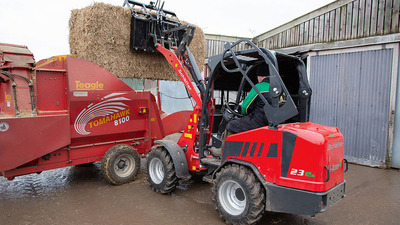
Batteries and charging
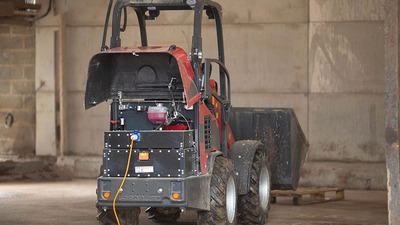
Under the bonnet, the diesel engine has been usurped in favour of lithium-ion battery packs, each providing 6.7kWh of storage capacity. The manufacture says at the time of the loader's launch, it was the first to offer this particular battery technology in a loader, with other manufacturers previously only offering lead-acid packs.
Benefits of Li-ion batteries are faster charging cycles, higher load rating and longer service life, says the manufacturer.
The 23e offers the option of a single or double power supply, each weighing about 100kg. Our test machine was equipped with the latter. These power banks provide electricity to a pair of motors at 260 volts: a 28hp (21kW) version providing power to all four wheels via a cardan shaft, and a 13hp (9.7kW) motor providing all the grunt needed for the 42 litres per minute hydraulic pump.
For charging there are two options. Either using the on-board charger which uses a 16 amp plug running at 230V as we did, or a stand-alone 400V external unit, running at 32A. In our experience, the manufacturer's guidelines were spot on, in that it took four hours to charge the loader to 80 per cent and a further hour to top up the batteries.
The company does, however, say the external charger will put four-fifths of the charge into the energy stores in as little 15 minutes per battery. In our eyes, this would be a necessity on many farms, especially if it is the main workhorse or if it is required to shift lots of muck in a short amount of time.
Running cost comparison
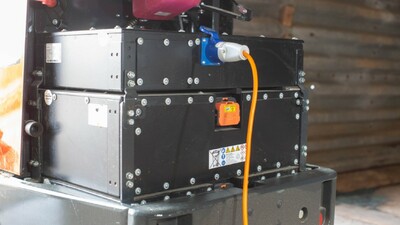
The company says reduced running costs are an added benefit of the electric loader, and this includes lower fuel costs.
A comparable diesel engine in the 40hp sector would typically be burning three to four litres per hour, according to the manufacturer. If the price of red diesel on farm is 60ppl, fuel cost per hour would be in the region of £1.80-£2.40.
Conversely, the cost to replenish the batteries on the 23e would cost £2.01 assuming the cost of electricity is 15p/kW and the full 13.4kWh of onboard storage was topped up. The loader can then run for three to five hours, giving a cost per hour of 40-67p.
Alternatively, if the farm has a renewable source of energy, recharging the batteries could cost far less than importing electricity from the grid.
text
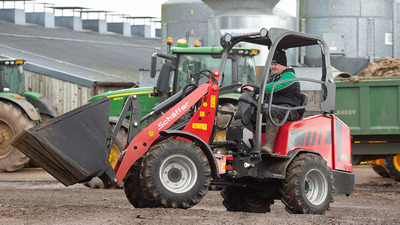
The manufacturer gives a warranty on the batteries for 5,000 charging cycles or five years, whichever comes first. Being lithium-ion, there is no memory effect, with the on-board charger shutting down when maximum charge is reached.
When running in full power mode and working the loader hard, we managed to drain the batteries to about 20 per cent, when a limp mode engaged. This is where you have to compromise with the electric loader. If low on diesel, a five-minute trip to the derv tank is hardly a hassle, whereas waiting for the go-go juice to replenish in the 23e can at times be more than just an inconvenience.
Usefully, when braking, the motor acts as a generator and recuperates energy, replenishing the batteries.
Operation
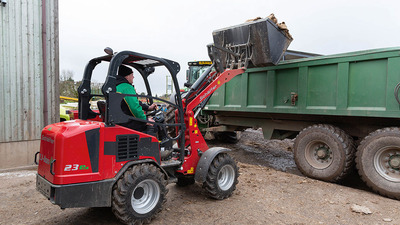
Schaffer says run time of the loader is up to five hours under what it calls ‘normal use', however, the nearest we got to that figure was four hours and 10 minutes of mixed work when mainly material handling.
The loader comes with two running modes: economy and full power. In economy mode, the motor is derated to 14.7hp (11kW). These are selected by a rocker switch on the steering column. When tootling around yards and backing up and down sheds the eco mode is ideal, as it is when hydraulic performance needs to be limited.
However, when ripping out full grabs of well compacted box muck or pushing chicken litter the length of the shed, full power mode is needed.
In this mode, performance is near faultless. We ran the 23e alongside its diesel equivalent and there was little to split the two machines in terms of pure pushing grunt. Where the electric machine was quicker off the line but struggled more at its top speed of 20kph, the diesel version was more consistent overall, resulting in a similar output from both.
The biggest differing factor was the tyre choice on the test machine, which was shod with 10.0/75-15.3 rubber from BKT. These being tall and relatively narrow at 274mm, gave up on grip long before the electric motor started flagging. Wider tyres, space permitting, would also give the loader a more planted feel, with the test machine a little unnerving when the boom was raised with a full bucket.
In addition, the loader has an inside turning radius of 835mm, with an oscillating pivot joint keeping all four wheels on the ground when traversing rough yards.
Schaffer 23e specifications
- Drive motor: 28hp (21kW)
- Hydraulic motor: 13hp (9.7kW)
- Battery: Lithium-ion 6.7kWh (option of a second battery)
- Lift capacity: 1,700kg
- Tipping load: 1,084-1,578kg
- Lift height: 2,880mm
- Hydraulic pump: Gear type, 42 litres per minute, 180bar
- Speed: 20kph
- Wheelbase: 1,550mm
- Dimensions (LxWxH) (with bucket): 3,880x1,060x2,215mm
- Weight: 2,300kg
- Retail price: £44,200 with one Li-ion battery.
- Optional second battery: £6,900
Hydraulics
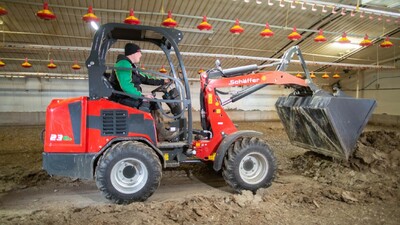
The electric version trumps the diesel burning model in a number of areas, not least in its whisper quiet and vibration-free operation. The hydraulic performance is impressive. Pull back on the joystick and the boom shoots up with ease, and without the need to stamp on the throttle pedal.
Boom response time was six seconds to raise and just three seconds to lower. For jobs requiring finesse, such as stacking pallets and unloading goods, eco mode is sufficient, giving more controllable modulation of the hydraulics. In full power mode the hydraulic response can be slightly too sharp, especially if not familiar with the characteristics of the loader.
The loader has a maximum lift capacity of 1,700kg, with a straight tipping load rating of 1,048-1,578kg depending on the attachment and the number of weight plates at the rear. The loader will lift to 2,880mm at full stretch.
Cab and controls

The joystick has a sliding switch for direction changes on the front and at the rear is a roller switch for the third service. Two buttons and another roller switch reside on the front, which are not assigned a function, making the joystick feel cluttered.
A feature we would like to see added to the joystick is a power on demand button which would unleash the loader's full potential when pressed. While eco mode is sufficient for the most part, occasionally a bit of power boost would be handy and negate the need to switch between the two modes when the going gets tough.
For comfort, the steering column is fully adjustable, as is the seat, providing operators with plenty of choice. When the operator leaves the seat, all functions are disabled after three seconds and the handbrake automatically activates.
On the steering column is the dashboard, showing the battery charge on a traffic light scale. It would be handy to know the exact percentage of energy left in the batteries. This is shown when charging commences. Also, on the steering column are the light switch, horn and hydraulic dump switch. Holding the dump switch releases the headstock pins. Double tap the switch and pressure to the third service is released.
Upon starting the loader a series of audible clicks can be heard as the computers coordinate themselves, taking about 10 seconds. You have to wait until this is finished, or the hydraulics are locked out.
The test machine came equipped with a protective roof canopy. The manufacturer says a fully enclosed cab will soon be available.
pic
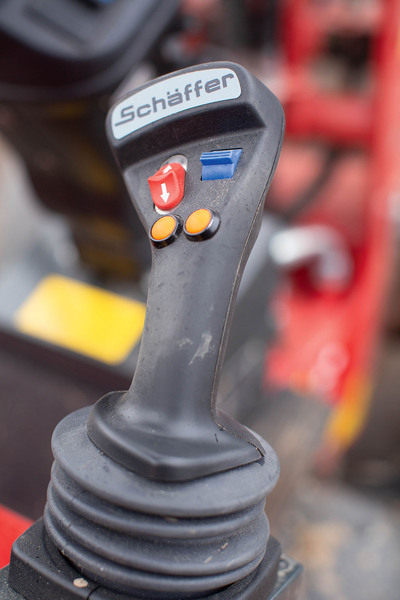
pic
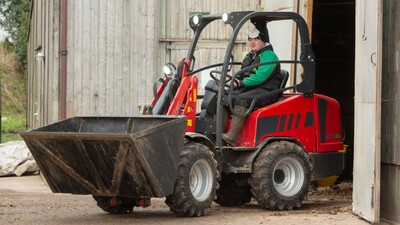
FG verdict
As the first compact loader to feature lithium-ion batteries, the 23e is to be commended for its performance.
Initially sceptical about whether it could compete with the grunt of a diesel motor, we were surprised to find it surpassed the fossil fuel burner in many areas of operation. Couple to this the lack of noise and vibrations and the electric loader is a tool which will appeal to many who are looking for a compact loader in the 40hp sector.
Interestingly, the diesel burning 2345 loader is being discontinued as a result of emission regulations, meaning the 23e now sits between the 25hp 2630 and the 50hp 3650.
The major concern for us would be charging times on a busy unit. The loader is the sort of machine which should be ready to go whenever it is needed. For this reason, we would recommend giving the fast charging system serious consideration to best utilise this powerful and versatile loader.






